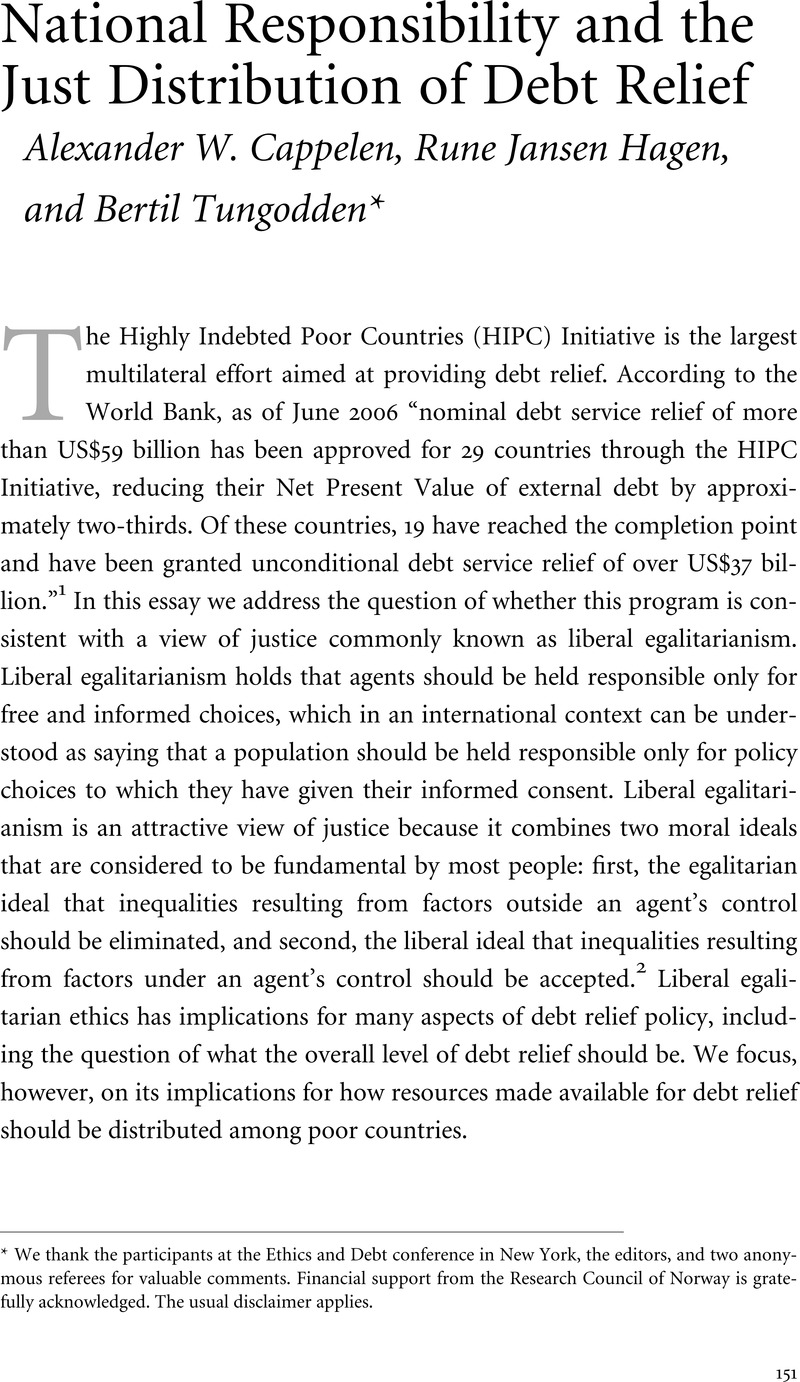No CrossRef data available.
Published online by Cambridge University Press: 25 March 2011

1 World Bank, “The Enhanced HIPC Initiative”, available at http:\\www.web.worldbank.org/WBSITE/EXTERNAL/TOPICS/EXTDEBTDEPT/0,,contentMDK:20260411~menuPK:64166739~pagePK:64166689~piPK:64166646~theSitePK:469043,00.html.
2 The contemporary focus on the relationship between these two ideals in the philosophical literature can be traced back to the seminal work of John Rawls, A Theory of Justice(Cambridge, MA: Harvard University Press, 1971), but the ideas of Rawls have been developed further, notably by Richard Arneson, “Equality and Equal Opportunity for Welfare, ” Philosophical Studies 56 (1989), pp. 77–93; Gerald Cohen, “On the Currency of Egalitarian Justice, ” Ethics 99 (1989), pp. 906–44; Ronald Dworkin, “What Is Equality? Part 2: Equality of Resources, ” Philosophy & Public Affairs 10 (1981), pp. 283–345; Marc Fleurbaey, “Equal Opportunity or Equal Social Outcome, ” Economics and Philosophy 11 (1995), pp. 25–55; John Roemer, Theories of Distributive Justice(Cambridge, MA: Harvard University Press, 1996); and John Roemer, Equality of Opportunity(Cambridge, MA: Harvard University Press, 2000).
3 David Andrews, Anthony R. Boote, Syed S. Rizavi, and Sukhwinder Singh, “Debt Relief for Low-Income Countries: The Enhanced HIPC Initiative” (Washington, D.C.: IMF Pamphlet Series, no. 51, 1999); available at http:\\www.imf.org/external/pubs/ft/pam/pam51/contents.htm.
4 See Amartya Sen, Development as Freedom(Oxford: Oxford University Press, 1999); Craig Burnside and David Dollar, “Aid, Policies, and Growth, ” American Economic Review 90 (2000), pp. 847–68; and William Easterly, The Elusive Quest for Growth(Cambridge, MA: MIT Press, 2002).
5 Ashfaq Khalfan, Jeff King, and Bryan Thomas, “Advancing the Odious Debt Doctrine” (Quebec: Centre for International Sustainable Development Law, 2003); available at http:\\www.odiousdebts.org/odiousdebts/publications/Advancing_the_Odious_Debt_Doctrine.pdf.
6 For a general discussion of the issue of group responsibility, see Kaushik Basu, Prelude to Political Economy(Oxford: Oxford University Press, 2000).
7 Marc Fleurbaey, “Three Solutions to the Compensation Problem, ” Journal of Economic Theory 65 (1995), pp. 505–21; and Walter Bossert and Marc Fleurbaey, “Redistribution and Compensation, ” Social Choice and Welfare 13 (1996), pp. 343–55.
8 For a description, see, e.g., Andrews, Boote, Rizavi, and Singh, “Debt Relief for Low-Income Countries”; and for assessments and evaluations from various angles, see Romilly Greenhill and Elena Sisti, “Real Progress Report on HIPC” (London: Jubilee Research, 2003), available at http:\\www.globalpolicy.org/socecon/develop/debt/2003/09realprogresshipc.pdf; Matthew Martin, “Assessing the HIPC Initiative: The Key Policy Debates, ” in Age Akkerman and Jan Joost Teunissen, eds., HIPC Debt Relief: Myths and Reality(The Hague: FONDAD, 2004); and World Bank, “Debt Relief for the Poorest: An OED Review of the HIPC Initiative” (Washington, D.C.: The World Bank Group, 2003), available at lnweb18.worldbank.org/oed/oeddoclib.nsf/0/86dd1e3dca61e0b985256cd700665b1c?OpenDocument.
9 The International Development Association (IDA) and the Poverty Reduction and Growth Facility (PRGF), respectively.
10 According to the IMF Web site, the five core principles of the PRSP approach are that the poverty-reduction strategies should be country-driven, results-oriented, comprehensive, partnership-oriented, and have a long-term perspective. See IMF, “Poverty Reduction Strategy Papers (PRSP), ” September 2005; available at http:\\www.imf.org/external/np/exr/facts/prsp.htm. Critics have questioned whether actual PRSP processes conform to these principles. In a major concession to these critics, the explicit endorsements of PRSPs by the executive boards of the World Bank and the IMF are no longer required for PRGF lending.
11 Cameroon reached the completion point in May 2006 and Malawi in August 2006.
12 Adjustments for PPP aim to make economic data comparable across countries by expressing them in terms of some common denominator. Here we use the most widely used denominator, which is called an international dollar. The international dollar by construction has the property that it has the same purchasing power over a country's GDP as the U.S. dollar has in the United States.
13 These two data series are taken from the online version of International Development Statistics, which is based on data collected by the Development Assistance Committee of the OECD from its member countries as well as other sources. While the subtraction of the principal and interest due in the decision-point year that has been canceled might also remove some debt relief that is unrelated to HIPC from our data, this is unlikely to matter given the scale of that program.
14 That poorer countries get more aid is one of the main findings of the aid allocation literature. See Alberto Alesina and David Dollar, “Who Gives Foreign Aid to Whom and Why?” Journal of Economic Growth 5 (2000), pp. 33–63; Peter Boone, “Politics and the Effectiveness of Foreign Aid, ” European Economic Review 40 (1996), pp. 289–329; Peter Cashel-Cordo and Steven G. Craig, “Donor Preferences and Recipient Fiscal Behavior: A Simultaneous Analysis of Foreign Aid, ” Economic Inquiry 35 (1997), pp. 653–71; and Lisa Chauvet, “Socio-Political Instability and the Allocation of International Aid by Donors, ” European Journal of Political Economy 19 (2002), pp. 33–59.
15 These results continue to hold even if one tries to correct for the fact that our measure of debt relief is not directly comparable to the flow concept of aid and that, as pointed out in Cohen, “On the Currency of Egalitarian Justice, ” the NPV of the debt relief exaggerates the gain to a country, since presumably much of the debt would not have been serviced in any case.
16 See Ales Bulir and A. Javier Hamann, “Aid Volatility: An Empirical Assessment, ” IMF Staff Papers 50 (2003), pp. 64–89; and Stephane Pallage and Michel Robe, “Foreign Aid and the Business Cycle, ” Review of International Economics 9 (2001), pp. 641–72.